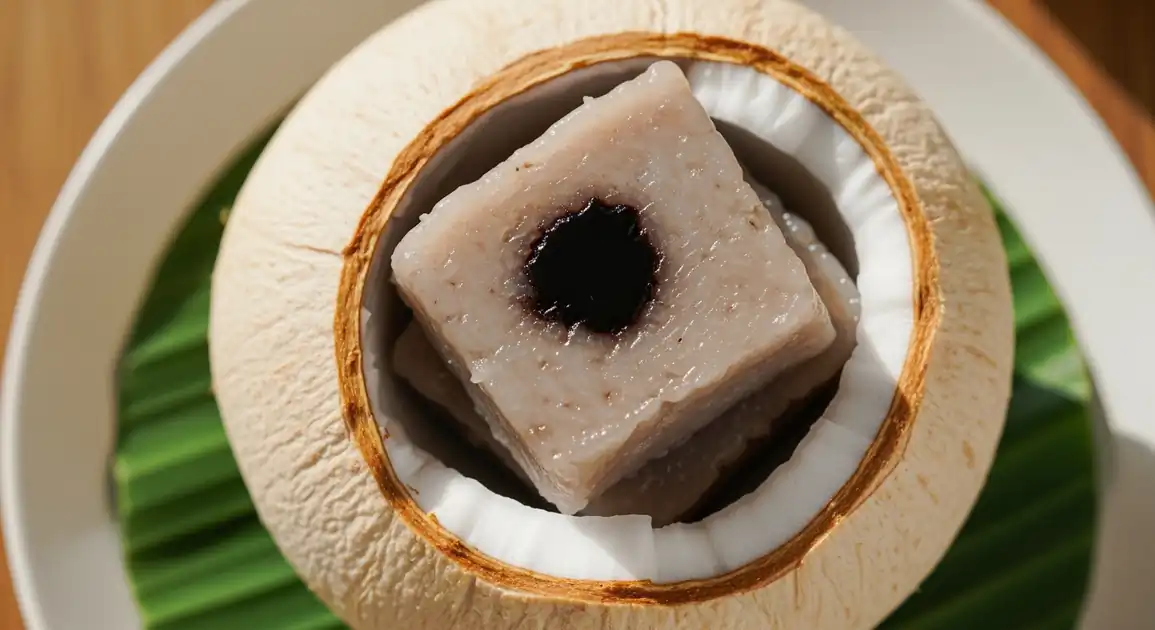Binagol
Binagol

Description
Binagol is a well-known delicacy originating from Eastern Visayas (Leyte, Samar) but is widely available throughout the Philippines, especially in 'pasalubong' centers catering to travelers bringing regional gifts home. Major cities often have access to Binagol shipped from its home region.
Dietary Information
Serving information
Serving style
Served at room temperature, directly from the coconut shell using a spoon. Often sold as a single unit intended as a gift or substantial snack.
Quick facts
Pasalubong centers and shops often open from morning until evening (e.g., 9 AM - 7 PM). Market stalls usually operate in the morning and early afternoon.
Safety Tips
What to Look For
-
Intact coconut shell packaging
Ensures the contents haven't been exposed or tampered with. Avoid cracked or damaged shells.
-
Secure banana leaf seal (if present)
Helps maintain freshness and indicates proper packaging.
-
Purchased from a reputable vendor
Trustworthy pasalubong centers or market stalls known for fresh products are safer bets than unknown sources.
-
Moist, slightly glossy appearance
Indicates freshness. Avoid Binagol that looks excessively dry or dull.
-
Pleasant sweet, coconutty smell
Should smell appetizing. Any sour, moldy, or off-putting odor indicates spoilage.
What to avoid
-
Cracked or damaged coconut shell
Compromises the integrity and safety of the product.
-
Visible mold on the shell, leaves, or product itself
Clear sign of spoilage; do not consume.
-
Sour or rancid smell
Indicates the product has gone bad.
-
Excessively dry or hardened appearance
Suggests it might be old or improperly stored.
-
Buying from dubious or unknown street vendors (unless highly recommended)
Pasalubong centers or established market stalls offer better traceability.
Price information
Price range
Budget tips
- Prices vary based on size and location. Expect to pay 80-200 PHP per piece.
- Buying directly in Leyte/Samar might be slightly cheaper.
- Pasalubong centers in major hubs might have slightly higher prices.
Value indicators
- Freshness (ask when delivered/made).
- Intact shell and seal.
- Good weight for its size (indicates density).
- Reputation of the source/brand if applicable.
Where to Find This Dish
Pasalubong Centers
Specialty shops near airports, bus terminals, ports, and tourist areas are prime locations.
Major transport hubs, Tourist districts
Store operating hours
Public Markets ('Palengke')
Stalls selling native delicacies ('kakanin') might carry Binagol, especially in Visayas.
Carbon Market (Cebu), Local markets in Visayas/Mindanao
Market hours (usually mornings)
Specialty Filipino Delicacy Stores
Stores focusing exclusively on traditional sweets and snacks.
Found in malls or specific neighborhoods
Store hours
Vendor Tips
- Ask about the origin (usually Leyte/Samar) to ensure authenticity.
- Inquire about freshness or the date it was made/delivered.
- Check the shell and seal carefully before purchasing.
How to Order
Regional Variations
-
Center Filling
(Palaman sa Gitna)
The central filling can vary, most commonly 'latik' (cooked coconut curds/caramel) or sometimes a sweet chocolate-based mixture.
-
Sweetness Level
(Antas ng Tamis)
Sweetness can vary slightly depending on the amount of sugar used in the recipe.
-
Texture
(Pagkakayari)
Some Binagol might be smoother, while others have a slightly coarser texture depending on the taro grating and mixing.
-
With/Without Egg Yolk/Condensed Milk
(May Itlog/Condensed Milk o Wala)
Some recipes add egg yolks or condensed milk for extra richness, affecting vegan status.
Cultural context
History
Binagol originated in the islands of Leyte and Samar in the Eastern Visayas region of the Philippines. The name 'Binagol' is believed to derive from the Waray word 'bagol', meaning coconut shell. It's a traditional 'kakanin' (native delicacy) often prepared for fiestas, special occasions, and as a valued gift, showcasing local ingredients like taro (gabi), coconut, and glutinous rice. Its unique cooking method within the shell helped preserve it slightly longer.
Local significance
Iconic delicacy from Eastern Visayas, representing regional culinary heritage. A popular 'pasalubong' item, symbolizing thoughtfulness and sharing regional bounty.
Eating customs
- Eaten directly from the shell with a spoon.
- Often shared due to its richness and density.